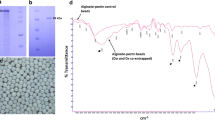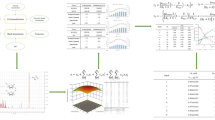Abstract
In recent decades, the production of palatinose has aroused great interest since this structural isomer of sucrose has interesting potential. We describe a simple and effective method of immobilizing Serratia plymuthica cells in chitosan. The sucrose isomerase activity of immobilized preparations was enhanced many times by activation with fresh nutrient medium and subsequent drying. The preparations obtained were physically very stable with high enzyme activity and excellent operational stability. The effect of temperature, pH and substrate concentration on enzyme activity of the immobilized cells was investigated. Using immobilized cells, a complete conversion of sucrose (40% solution) into palatinose was achieved in 4 h in a "batch"-type enzyme reactor. The use of free or immobilized cells had no effect on the composition of the solution, in particular the sugar content. The palatinose content was 80% and that of trehalulose 7%.








Similar content being viewed by others
References
Adachi S (1965) Thin-layer chromatography of carbohydrates in the presence of bisulfite. J Chromatogr 17:295–299
Bucke C, Cheetham PSJ (1982) Production of isomaltulose. US Patent 4359531
Cheetham PSJ (1983) The extraction and mechanism of a novel isomaltulose-synthesizing enzyme from Erwinia rhapontici. Biochem J 220:213–220
Cheetham PSJ, Imber CE, Isherwood J (1982) The formation of isomaltulose by immobilized Erwinia rhapontici. Nature 299:628–631
Cheetham PSJ, Garrett C, Clark J (1985) Isomaltulose production using immobilized cells. Biotechnol Bioeng 27:471–481
Fujii S, Kishihara S, Komoto M, Shimizu J (1983) Isolation and characterization of oligosaccharides produced from sucrose by transglucosylation action of Serratia plymuthica. Nippon Shokuhin Kogyo Gakkaishi 30:339–344
Goda T, Hosoya N (1983) Hydrolysis of palatinose by rat intestinal sucrase-isomaltase complex. J Jpn Soc Nutr Food Sci 36:169–173
McAllister M, Kelly CT, Doyle E, Fogarty WM (1990) The isomaltulose synthesizing enzyme of Serratia plymuthica. Biotechnol Lett 12:667–672
Minami T, Fujiwara T, Ooshima T, Nakajima Y, Hamada S (1990) Interaction of structural isomers of sucrose in the reaction between sucrose and glucosyltransferases from mutans streptococci. Oral Microbiol Immunol 5:189–194
Mizutani T (1991) Preparation and use of palatinose oligosaccharides. New Food Ind 33:9–16
Ooshima T, Izumitani A, Minami T, Fujiwara T, Nakajima Y, Hamada S (1991) Trehalulose does not induce caries in rats infected with mutans streptococci. Caries Res 25:227–282
Veronese T, Perlot P (1998) Proposition for the biochemical mechanism occurring in the sucrose isomerase active site. FEBS Lett 441:348–352
Veronese T, Perlot P (1999) Mechanism of sucrose conversion by the sucrose isomerase of Serratia plymuthica ATCC 15928. Enzyme Microb Technol 24:263–269
Vorlop KD, Klein J (1987) Entrapment of microbial cells in chitosan. In: Mosbach K (ed) Methods in enzymology, vol. 135. Academic Press, New York, pp 259–268
Yamada K, Shinhara H, Hosoya N (1985) Hydrolysis of 1-O-α-d-glucopyranosyl-d-fructofuranose by rat intestinal sucrase-isomaltase complex. Nutr Rep Int 32:1211–1222
Acknowledgements
The authors thank Prof. Seki, Dr. Nakajima and Dr. Fujiyama from ICBiotech, Osaka University for their help. This work was supported by ICBiotech, Osaka University, Japan
Author information
Authors and Affiliations
Corresponding author
Rights and permissions
About this article
Cite this article
Krastanov, A., Yoshida, T. Production of palatinose using Serratia plymuthica cells immobilized in chitosan. J IND MICROBIOL BIOTECHNOL 30, 593–598 (2003). https://doi.org/10.1007/s10295-003-0087-4
Received:
Accepted:
Published:
Issue Date:
DOI: https://doi.org/10.1007/s10295-003-0087-4




